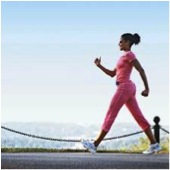By: Cheryl Mitchell, IFTA Certified Group Fitness Instructor
April 2017
This past winter was brutal. Thankfully, spring is finally here. If you haven’t already, get out your sneakers and walk. For most of us, walking is one of the easiest least expensive forms of physical activity. Other than a comfortable pair of well-supported sneakers and comfortable breathable clothing, nothing else is needed. Most of us know that walking with regularity 20-30 minutes a day can help you lose or control your weight-Taking a brisk walk for 30-minutes can burn approximately 200 calories. But there are several other benefits you may not be aware of:
- Respiratory Benefits: Brisk walking oxygenate the lungs and bronchi, and gradually increase the capacity of the respiratory system.
- Cardiac Benefits: Walking can strengthen the heart, improve circulation throughout the body, and lower blood pressure. It also helps ward off heart disease and decrease one’s chances of stroke. The cardiac benefits alone should be enough incentive for people to start walking.
- Varicose Veins: “As we age, our risk of unsightly varicose veins increases—it’s just not fair. However, walking is a proven way to prevent those unsightly lines from developing, says Luis Navarro, MD, founder & director ofThe Vein Treatment Center in New York City (www.prevention.com/fitness/benefits-walking-every-day).”
- Bone/Muscle Benefits: Walking strengthens and tones the legs and abdominal muscles. Walking also helps ward off bone loss by strengthening the bones.
- Vitamin D absorption: Walk outdoors–Your body is designed to get the vitamin D it needs by producing it when your bare skin is exposed to sunlight.
- Improves your mood: Walking for just 30 minutes per day five days per week has been found to boost energy, help adults feel more confident and healthier, and even improve their ability to complete daily tasks — all traits that can help to lift mood and fight depressive symptoms.
- Walking lowers Alzheimer’s risk:“A study from the University of Virginia Health System in Charlottesville found that men between the ages of 71 and 93 who walked more than a quarter of a mile per day had half the incidence of dementia and Alzheimer’s disease, compared to those who walked less (http://www.arthritis.org/living-with-arthritis/exercise/workouts/walking/wow-of-walking.php)”
- Walking slows mental decline: “A study of 6,000 women, ages 65 and older, performed by researchers at the University of California, San Francisco, found that age-related memory decline was lower in those who walked more. The women walking 2.5 miles per day had a 17-percent decline in memory, as opposed to a 25-percent decline in women who walked less than a half-mile per week (http://www.arthritis.org/living-with-arthritis/exercise/workouts/walking/wow-of-walking.php).”
- Walking can improve relationships: We live in a world where people communicate mainly through texts, e-mails, phone calls, Snapchat, Facebook, or Twitter even with people living in close proximity. Instead of using these methods, where feasible, invite a loved one or friend to go for a brisk walk. There is nothing like communicating in person to improve relationships while getting some exercise in at the same time.
My mom loved taking long walks but stopped after developing several chronic conditions including osteoarthritis. She told me her joints bothered her too much to go for walks. Her doctor advised me that walking would help her with the stiffness and pain she felt in the joints. I invited her to walk with me on several occasions. She insisted she was not up to it. Mom and I had several conversations about all sorts of topics at her kitchen table. One day, I told her I really needed her advice. She told me I had her full attention and as always, she sat down at the table. I told her I needed some fresh air and asked if we could talk while we walked outside (It was about this time of year). We walked and talked for about fifteen minutes. Not once during our walk did she complain about her joints! From that day on, every time I visited her, I told her I needed to talk and we went outside. After about a month, she started inviting me outside for walk because she wanted us to talk outside and admitted she felt better when she walked. Our walks eventually went from fifteen minutes to forty minutes.
Recommendation:
For beginner walkers, start walking with a distance and pace that can easily be accomplished without pain or fatigue-Gradually increase the distance and pace working towards completing 30 minutes of walking at a moderate pace.
Before starting any fitness program including walking, always consult with your medical treating source.
Disclaimer: This article is provided as informational only and should not be relied upon as medical advice.
Resources:
Fitness Professional’s Handbook by Edward T. Howley and Dixie L. Thompson
www.vitamindcouncil.org/about-vitamin-d/how-do-i-get-the-vitamin-d-my-body-needs/ www.prevention.com/fitness/benefits-walking-every-day
http://www.arthritis.org/living-with-arthritis/exercise/workouts/walking/wow-of-walking.php












